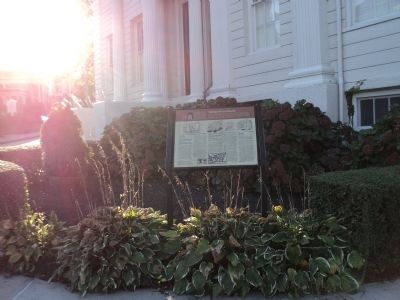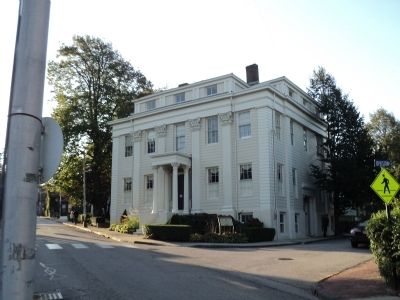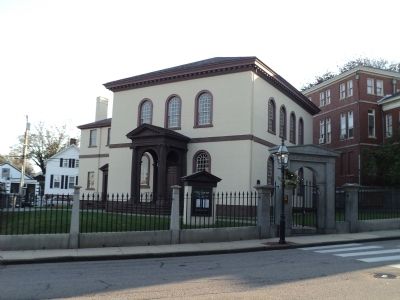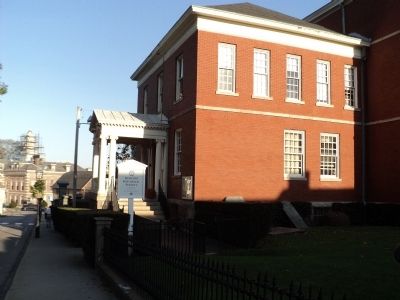Newport in Newport County, Rhode Island — The American Northeast (New England)
Touro Synagogue
The results of the religious toleration upon which Newport was founded are nowhere more evident than in the houses of worship clustered within a few hundred feet of this location: Touro Synagogue, the Seventh Day Baptist Meeting House, the United Baptist Church, and the former Zion Episcopal Church (now the Jane Pickens Theater). Nowhere else in colonial New England did so many different congregations live in such close and harmonious proximity.
72 Touro Street
Touro Synagogue
1763
Architectural Style : Neo-Palladian
Look for : Rigid symmetry of the plan, small ell to the left which is original to the building and was built as the congregation’s school and meeting hall.
• Touro Synagogue, the oldest synagogue in the United States is an international symbol of religious freedom and was designated a National Historical Site in 1946.
In 1658, fifteen Sephardic Jewish families arrived in Newport and the history of one of the most historic Jewish congregations in America began. Fleeing from the terrors of the Inquisition in their ancestral homelands of Spain and Portugal, many of these families came to Newport by way of Barbados, Jamaica, Surinam, Curacao, and the Netherlands. They were attracted to Newport by a religious freedom many of them never had known before.
Most of these first settlers were merchants with experience in international trade. However, when they first arrived, the town’s economy had not developed sufficiently to support this sort of mercantile activity. As a result, most of Newport’s Jews left for New York at the end of the 17th century. By the 1730s, the town’s economy had blossomed and the Jews returned. This time, they prospered. By the time of the American Revolution, Jewish merchants like Aaron Lopez and Jacob Rodrigues Rivera had helped transform Newport from a simple agricultural settlement into one of the five most important colonial seaports in America.
By 1759, the Jewish community, under the guidance of the Reverend Isaac Touro, undertook the construction of this synagogue. They selected architect Peter Harrison, who had established his reputation with the design of the Redwood Library. Harrison also worked on the designs for the Brick Market as the construction of Touro Synagogue neared completion.
Touro Synagogue is one of America’s finest examples of classically inspired colonial architecture. The building stands on its lot at an angle so that the ark holding the Torahs faces due east toward Jerusalem, as is the case with all synagogues. This placement on the hill rising out of the colonial village, coupled with its classical symmetry, made a very powerful statement in its time. It strongly proclaimed the confidence felt by the Jewish community in Newport’s continued commitment to religious toleration.
Touro Synagogue was completed and dedicated in 1763. Most of its members fled Newport during the Revolution and the synagogue remained closed for regular worship services for much of the 19th century. During this time, it served as a meeting place for the City Council, the Rhode Island General Assembly, and the Rhode Island Supreme Court. Two sons of Isaac Touro, Judah and Abraham Touro, made large bequests that enabled the synagogue to be maintained through the 19th century. It was reconsecrated in 1883, and has been open for services ever since. It still stands as a symbol of Newport’s early commitment to religious liberty.
82 Touro Street
Seventh Day Baptist Meeting House
and Newport Historical Society
1730 and 1915
• The Seventh Day Baptist Meeting House is attached to the back of the Newport Historical Society building. The Historical Society created the Self-guided Walking Tour of the Historic Hill and The Museum of Newport History at the Brick Market.
In the 1660s, a group within the First Baptist Church became convinced that the Ten Commandments should be observed literally and that the Sabbath should be observed on Saturday, the seventh day of the week. In 1671 this group formed the Seventh Day Baptist Church. The freedom
to entertain doctrinal differences such as these was possible in Newport because of the religious toleration on which the town was founded.
Some of Newport’s most prominent families were members of the Seventh Day Baptist Church. One of them, Henry Collins, a wealthy merchant and cultural patron, donated a portion of his land in the 1740s to be used as the site for the Redwood Library. By 1729, the congregation had outgrown its first home and hired Richard Munday, fresh from completing Trinity Church in 1726, to design a new building for them on Barney Street. Munday’s last commission was the Colony House, which was completed in 1739 after his death.
The new building was laid out in the “meeting house plan,” typical of many colonial churches in the 17th century, whose members sought to purify the excesses of the Church of England. The meeting house plan avoided the cruciform floorplan of traditional churches in England and Europe. Instead, the Seventh Day Baptists built a simple house. While Munday’s building was simple in plan, it was elaborate in detail. The interior woodwork is a testament to the virtuostic skill of Newport’s craftsmen.
The Seventh Day Baptist congregation flourished in Newport until the Revolution, when most members scattered to avoid the British occupation. Many relocated in Westerly, Rhode Island, a stronghold of the Seventh
Day Baptists since 1676. Between 1840 and 1869, the Seventh Day Baptists rented the meeting house to the Fourth Baptist Church and then to Shiloh Baptist Church, and African-American congregation. Another well-known contemporary church, The Seventh Day Adventists, split from the Seventh Day Baptists in Michigan in the 1840s.
The Seventh Day Baptist Meeting House was sold to the Newport Historical Society in 1884 and became the first permanent headquarters of the Society since its founding in 1853. It was restored by Newport architect George Champlin Mason, Jr. In 1887, the Society moved the building to this site. In 1902 and 1915, additions were made to the building and the meeting house was enclosed in brick to fireproof it.
The Newport Historical Society is steward of a nationally important collection of historical research material and hosts many changing exhibits, frequent programs, and walking tours throughout the year.
85 Touro Street
Levi Gale House
1835
Architectural Style : Greek Revival
Look for : Rectangular pilasters with elaborate Corinthian capitals that decorate the exterior.
• This building was moved from Washington Square to make way for the Newport County Courthouse.
This house was designed by Russell Warren in 1835 for lawyer Levi H. Gale. Warren worked primarily in Bristol and Providence and was one of Rhode Island’s most distinguished 19th century architects. His works in Newport include the Zion Church (now the Jane Pickens Theater on Touro Street) and the General Assembly room in the Colony House.
The Levi Gale House is a wooden Greek Revival style building. Its corners have quoins or bricks set at alternate lengths to give a step-like effect up the side of the building. Full columns form the elaborate entrance porches. Greek Revival architecture became popular in Newport and around the country partly because many Americans identified with the Greeks as they fought for independence from the Turks between 1821 and 1829. It was America’s first “national” style of architecture.
In 1925, the State of Rhode Island bought the land and buildings at the head of Washington Square from William Paine Sheffield to build a courthouse. Rather than let this building be torn down, Congregation Joshua Israel of Touro Synagogue it for use as a Jewish community center. In 1926 it was cut in half and moved in sections from the square to this site. The exterior has remained largely unchanged, although the interior has been renovated. Throughout the 1920s and 30s, the community center was used by many organizations. During World War II, it was used by the USO.
Today the building still functions as a community center for the congregation and the headquarters
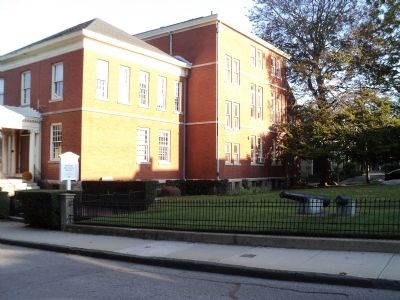
Photographed By Bill Coughlin, October 8, 2011
6. Seventh Day Baptist Meeting House
The Seventh Day Baptist Meeting House can be seen on the right, attached to the back of the Newport Historical Society building. The two guns beside the building are from Rhode Island's Sloop of War Tartar. The ship had a notable career, especially at the Battle of Louisbourg (1758) during the French and Indian War.
Topics. This historical marker is listed in these topic lists: Churches & Religion • Notable Buildings. A significant historical year for this entry is 1763.
Location. 41° 29.355′ N, 71° 18.731′ W. Marker is in Newport, Rhode Island, in Newport County. Marker is at the intersection of Touro Street and Division Street, on the right when traveling south on Touro Street. Touch for map. Marker is in this post office area: Newport RI 02840, United States of America. Touch for directions.
Other nearby markers. At least 8 other markers are within walking distance of this marker. Gideon Cornell House (here, next to this marker); a different marker also named Touro Synagogue (a few steps from this marker); Charlotte Burleigh House (within shouting distance of this marker); The Letter from Moses Seixas (within shouting distance of this marker); The Famous Letter by President George Washington (within shouting distance of this marker); The New Jersey House (within shouting distance of this marker); Buffum-Redwood House (within shouting distance of this marker); Elisha Johnson House (within shouting distance of this marker). Touch for a list and map of all markers in Newport.
More about this marker. Pictures of the Touro Synagogue, Seventh Day Baptist Meeting House, and Levi Gale House appear at the top of the marker. At the bottom of the marker are two maps of the Walking Tour of the Historic Hill in Newport.
Credits. This page was last revised on June 16, 2016. It was originally submitted on October 20, 2011, by Bill Coughlin of Woodland Park, New Jersey. This page has been viewed 1,232 times since then and 19 times this year. Photos: 1, 2, 3, 4, 5, 6. submitted on October 20, 2011, by Bill Coughlin of Woodland Park, New Jersey.

